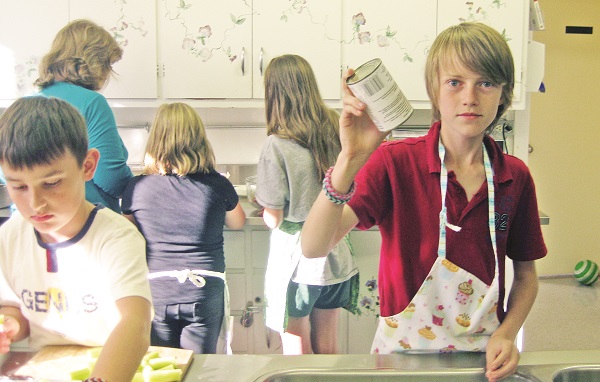Archive
Kids unleash their inner Nigella Lawson and Gordon Ramsay
January 8, 2014 · 0 Comments

By Brock Weir
It’s no secret that a lot of young guys are secretly whizzes in the kitchen, but how many of them would want to be “caught” in a family studies, or “home ec” course at school?
For Mary Becker, that just might be the key to the success of Pots and Pins.
Pots and Pins is a community-run program which aims to teach the basics of cooking and sewing to students across Aurora. Operated out of St. Andrew’s Presbyterian Church at Victoria and Mosley, the program was initially founded in the days of Wells Street Public School. When their home economics program was shut down to middle school children, Pots and Pins came together to fill the gap and provide a useful “life skill” to students.
“It appeals to kids because we get a lot of guys who want to learn how to cook,” says Ms. Becker, a coordinator of the program. “There are no programs out there for kids who want to see what being a chef would be like, culinary school, or anything like that until you get to high school now – and most guys are not going to want to take home ec!
“When you are 10 or 11 and you take this after school program, it is outside the school system so it is a bit freer for kids from their point of view. I think when you get to high school [ideas of gender roles] becomes a big part of it. There is certainly a lot more gender segregation, but when you hit middle school it starts happening. Kids in Grades 7, 8 and 9 really start to define their roles much more clearly.”
Pots and Pins, however, seems to erase those lines. It is open to boys and girls in their middle school years. They run eight week sessions twice a year – the latest of which begins this month—where they have cooked eight separate three-course meals, all with an international flavour, and multiple sewing projects which they can take home.
“We have a lot of fun, they are having fun, and I am having fun by teaching them,” says Ms. Becker. “It is more of a hobby rather than a formal teaching situation because you are learning by doing. There is actually a lot of enjoyment and community spirit sitting down at a meal everyone has just made together. There is also the enjoyment I get seeing them go home and then [hear back from parents] they have done the recipes again for their family.”
Students prepare entrees, side dishes and desserts. Cooking and baking skills are combined and often students put these skills into action baking goodies for Christmas baskets, or dusting off sewing machines at home and putting their lessons to good use by whipping up scads of coasters and quilts.
“They get a real satisfaction and true self esteem from having succeeded,” says Ms. Becker.
In the nearly 13 years since Pots & Pins’ inception, participation has waxed and waned throughout the years. There was a bit of a wane when Wells Street closed simply because it wasn’t just around the corner. Interest over the next couple of years greatly improved, attracting a wide cross-section of the community.
Aside from teaching the basics of a three course meal, they also focus on proper chopping and preparation techniques, safe use of ovens, stoves, microwaves, and kettles, as well as safe food preparation, particularly in handling and cooking raw meat. Students, she says, come out with a much better understanding of “what goes into an actual meal instead of pulling something out of a freezer pack.”
Pots aside, here come the pins. Sewing skills are taught primarily with sewing machines and from there students often take on quilting techniques.
“Quilting is actually a fairly popular hobby at the moment, so they are learning actual techniques and making actual things,” she says. “They have made tote bags, place mats, and even small quilts.”
Eight week sessions begin next week. Each session is $40 per student, which goes towards the purchasing of materials and food. Students are signed up for the full eight week sessions to build upon the skills learned at each level.
“At the end of eight weeks, you will have sewn at least one complete, finished sewing product, and more likely two or three,” says Ms. Becker. “You would have cooked eight separate, three-course meals from all different cuisines like Mexican, Italian, Chinese and North America. Many of them come for more than one session and we hear about how they go home and want to practice doing stuff in the kitchen at home.”













